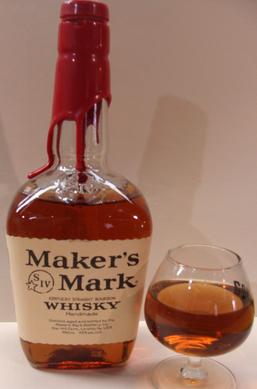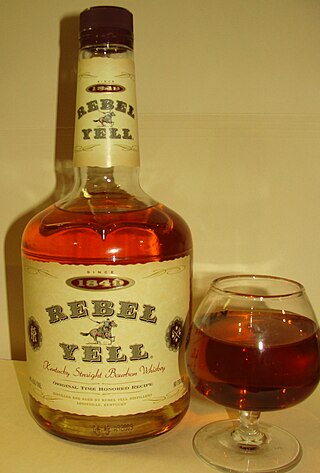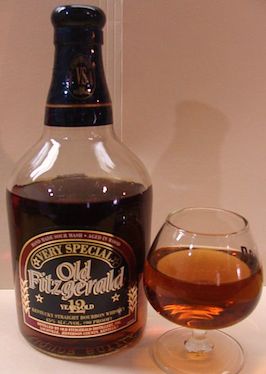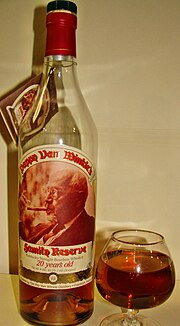
Maker's Mark is a small-batch bourbon whiskey produced in Loretto, Kentucky, by Beam Suntory. It is bottled at 90 U.S. proof and sold in squarish bottles sealed with red wax. The distillery offers tours, and is part of the American Whiskey Trail and the Kentucky Bourbon Trail.

Evan Williams is a brand of Kentucky straight bourbon whiskey bottled in Bardstown, Kentucky, by the Heaven Hill company. The product is aged for a minimum of four years. It has been ranked as one of the world's best selling whiskey brands.

Heaven Hill Distilleries, Inc. is a private, American family-owned and operated distillery founded in 1935 and headquartered in Bardstown, Kentucky, that produces and markets the Heaven Hill brand of Kentucky Straight Bourbon Whiskey and a variety of other distilled spirits.

Eagle Rare is a brand of bourbon whiskey distilled and distributed by the Buffalo Trace Distillery. Eagle Rare is 90 proof bourbon, aged for either 10 or 17 years, depending on the variety. It was introduced in 1975 and is distilled in Frankfort, Kentucky.

Rebel, formerly Rebel Yell until 2020, is a brand of Kentucky straight bourbon whiskey owned and marketed by MGP Ingredients. Rebel Yell is currently distilled and aged at the Lux Row Distillery, in Bardstown, Kentucky, which opened in 2018. As is typical for a bourbon, it is sold at 40% alcohol by volume. Before the opening of the Lux Row Distillery, the brand was produced under contract by Heaven Hill at its Bernheim distillery in Louisville.

Single barrel whiskey is a premium class of whiskey in which each bottle comes from an individual aging barrel, instead of coming from blending together the contents of various barrels to provide uniformity of color and taste. By contrast, some other whiskeys, even ones that are not blends, may be combined from more than one batch, or even from differing years to achieve consistency. The whiskey from each barrel is bottled separately, with each bottle bearing the barrel number and in most cases the dates for the beginning and end of aging. Each barrel is believed to contribute unique characteristics to the finished whiskey.

Buffalo Trace Distillery is a distillery in Frankfort, Kentucky, United States, owned by the Sazerac Company. It has historically been known by several names, including the George T. Stagg Distillery and the Old Fashioned Copper (O.F.C.) Distillery. Its namesake bourbon brand, Buffalo Trace Kentucky Straight Bourbon whiskey, was introduced in August 1999. The name "Buffalo Trace" refers to the ancient buffalo trackway that crosses the Kentucky River in Franklin County, Kentucky. The Sazerac Company purchased the distillery in 1992.

The Kentucky Bourbon Trail, sometimes informally referred to as "the Bourbon Trail", is a program sponsored by the Kentucky Distillers' Association (KDA) to promote the Bourbon whiskey industry in Kentucky. The KDA has registered the phrase "Kentucky Bourbon Trail" as a protected trademark.
W. L. Weller is a brand of "wheated" bourbon whiskey. The brand was created by the Stitzel-Weller Distilling Company, and was sold several times after 1972. Since 1999, the brand has been owned by the Sazerac Company. It is produced at the Buffalo Trace Distillery in Frankfort, Kentucky. Like all bourbons, Weller is distilled from a mash composed of at least 51% corn (maize). The secondary grain used for the Weller brand is wheat, whereas most bourbons use rye.

Old Fitzgerald is a brand of wheated bourbon distilled in Louisville, Kentucky, by Heaven Hill Distilleries, Inc.

Willett Distillery Ltd, is a private, family-owned-and-operated company that produces bourbon and rye whiskey. Over the years, the company has bottled whiskeys that range from two years of aging maturity up to 28 years. The company was named Kentucky Bourbon Distillers (KBD) between 1984 and 2012.

Glenmore Distillery Company was a large distillery company based in Owensboro, Kentucky best known as a producer of bourbon whiskey. In 2009, the company was acquired by the Sazerac Company, and is still operated under the name "The Glenmore Distillery".

Blanton's is a brand of bourbon whiskey produced and marketed by the Sazerac Company. Though it does not own the brand, it has exclusive distilling rights. It is owned by Age International, Inc. It is distilled in Frankfort, Kentucky at the Buffalo Trace Distillery.

Sazerac Company, Inc. is a privately held American alcoholic beverage company headquartered in Metairie in the metropolitan area of New Orleans, Louisiana, but with its principal office in Louisville, Kentucky. The company is owned by billionaire William Goldring and his family. As of 2017, it operated nine distilleries, had 2,000 employees, and operated in 112 countries. It is one of the two largest spirits companies in the United States, with annual revenue of about $1 billion made from selling about 300 beverage brands.

Willett Pot Still Reserve Bourbon is brand of a bourbon whiskey produced in Bardstown, Kentucky by the Willett Distillery.

Old Rip Van Winkle Bourbon Whiskey is a Kentucky Straight Bourbon whiskey produced by the Sazerac Company at its Buffalo Trace Distillery in Frankfort, Kentucky. It is sold in 750ml glass bottles. The primary brand expression is aged 10 years.

Stitzel–Weller Distillery is a former distillery located in Shively, a suburb of Louisville, Kentucky. It was founded in 1935, sold in 1972, and closed in 1992. It produced a number of notable brands, and since 2014 it has served as a public tourism site for Bulleit Bourbon, as part of the Kentucky Bourbon Trail.
Vintage spirits, also known as dusties, are old, discontinued, or otherwise rare bottles of liquor. The collectibility of a bottle is based on rarity, with age as a secondary factor. The name "dusty" refers to the fact that many such now-collectible bottles had been sitting on a liquor store shelf or unopened in a home or in a restaurant bar for years, collecting dust. In the United States, sales of vintage liquor is generally illegal, the exception being Kentucky, which is a frequent hunting ground for dusties for a variety of reasons.
















